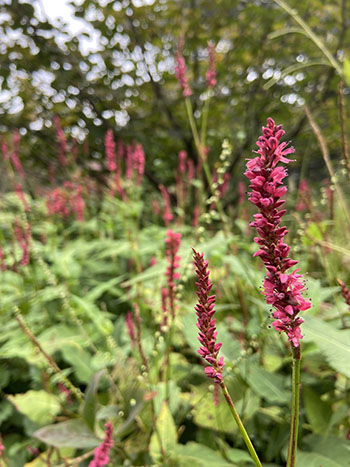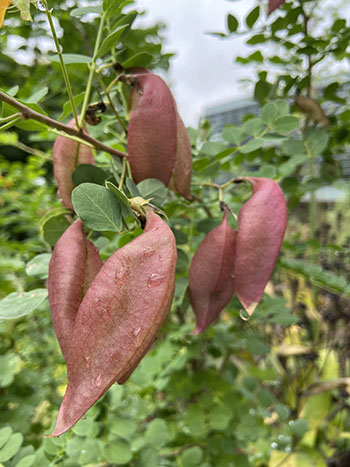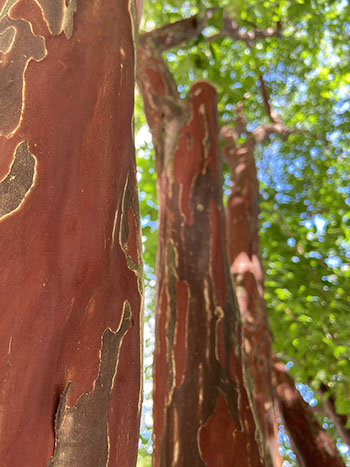
Plants of the Week: September 14

Persicaria amplexicaulis ‘Firetail’ (mountain fleece)
Part of my responsibility as an intern here at the Scott Arboretum is to assist with creating small flower arrangements, used in the Wister Center. Equipped with my pruners, a small glass vase, and a sense of artistic curiosity, I head out into the gardens, looking for eye-catching flowers and textural foliage. One such flower that has made its way into many of my floral compositions is Persicaria amplexicaulis ‘Firetail’ (mountain fleece).
This herbaceous perennial is certainly long-lasting and its wonderfully rosy-red spired flowers can be enjoyed from June until early October. Rising above clumped dark green foliage, the graceful wand-like flowers appear as though they’re floating; their airy nature adding whimsey and movement to any space. A delicate dash of color that bodes well for borders, along ponds and streams, or in harmonious meadow plantings.
This zone 4-7 plant can be grown in full sun to partial shade, in medium to wet soils. While not a bully in the landscape, it does self-seed and is best suited in locations where it has room to grow and expand. I certainly find much joy in seeing this plant in the Scott Entrance Garden and having the opportunity to use it in my arrangements, where it adds verticality, color, and of course, delight. photo credit: M. Rossman

Colutea x media ‘Copper Beauty’ (bladder senna)
I enjoy watching how others move throughout a garden space: what their eyes rest on, what plants catch their attention. One thing I notice in particular, is that when enticed by a particular plant, most people will reach out to touch it, needing that physical connection to satiate their tactile curiosity. Touch is an important key in activating all the senses in the garden, and there are certainly plants that draw more hands towards them than others. One example is Colutea x media ‘Copper Beauty’ (bladder senna).
Located in the John W. Nason Garden, this deciduous shrub demands closer inspection through its papery seed pods that develop in late summer. As the enclosed seeds ripen, the pinkish-orange pods inflate to create balloon-like bladders hanging down from the branches. One cannot help themself from reaching out to squeeze the seed pod and experience the enjoyment of this unusual reproductive stage.
Notable apart from its seed pods, this zone 5-7 plant has orange and yellow pea-like blooms and bluish-green foliage that, all together create an airy appearance. While preferring full sun and dryish conditions, it does not perform well in hot and humid summer climates. Long blooming, the bladder senna is curious, fun, and ornamental and will certainly add delight to your space and your day. photo credit: M. Rossman

Lagerstroemia subcostata var. fauriei ‘Townhouse’ (Japanese crapemyrtle)
As the weather slowly starts to ebb towards the cooler end of the temperature range and I start to add more layers, there are some plants that have just begun to shed theirs. And what’s underneath is stunning and eye-catching.
Lagerstroemia subcostata var. fauriei ‘Townhouse’ (Japanese crapemyrtle) had shed its outermost bark and I could not be more delighted. Cinnamon red and mahogany, the colors of this bark create a fantastic tapestry that only increases in interest and intensity as you approach. The exfoliating bark lays at the base of this quite large, multi-stemmed Japanese crapemyrtle. Accessioned in 1992, this specimen is located on the south side of Trotter Hall where arboretum visitors can revel in its striking branches.
Growing best in sunny sites with well-draining soil, this plant has fragrant white flowers in mid- to late-summer and has a brief, but striking display of fall color. I highly recommend getting up close to the Lagerstroemia subcostata var. fauriei ‘Townhouse’ and experiencing this delight of color here at the Scott Arboretum. photo credit: M. Rossman





John Schucker
Posted at 07:36h, 30 SeptemberThank you for your especially well-written descriptions of these plants. I was just shopping for some native plants yesterday and often caught myself reaching to touch interesting foliage. Amazingly, plants can engage all 5 of our senses.